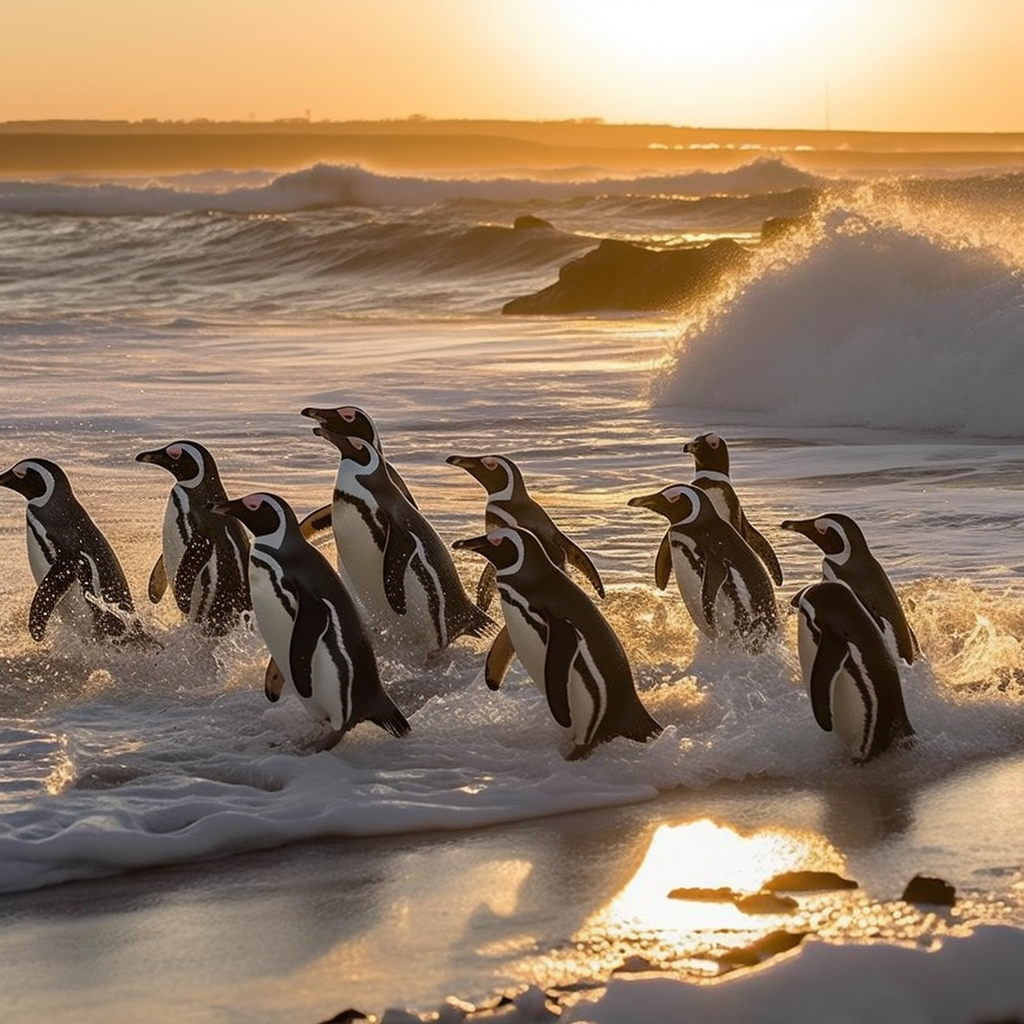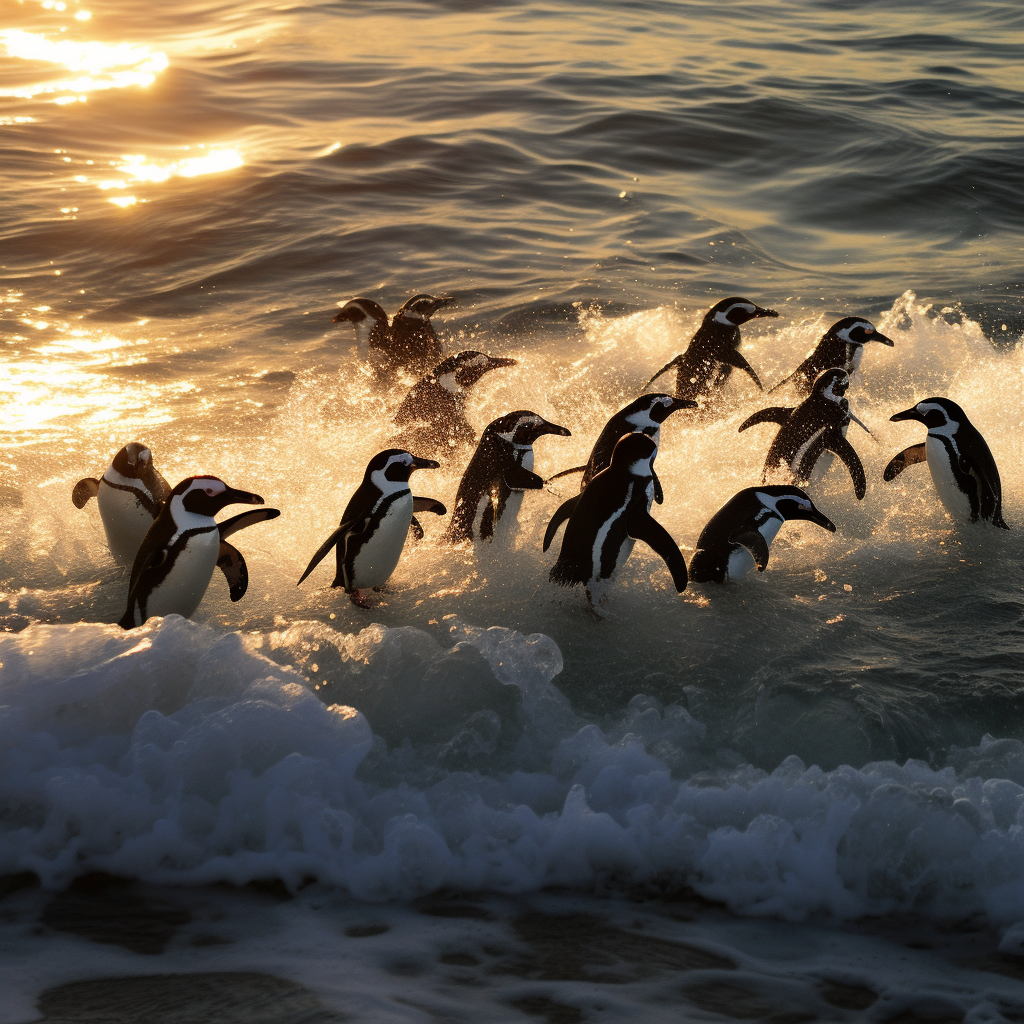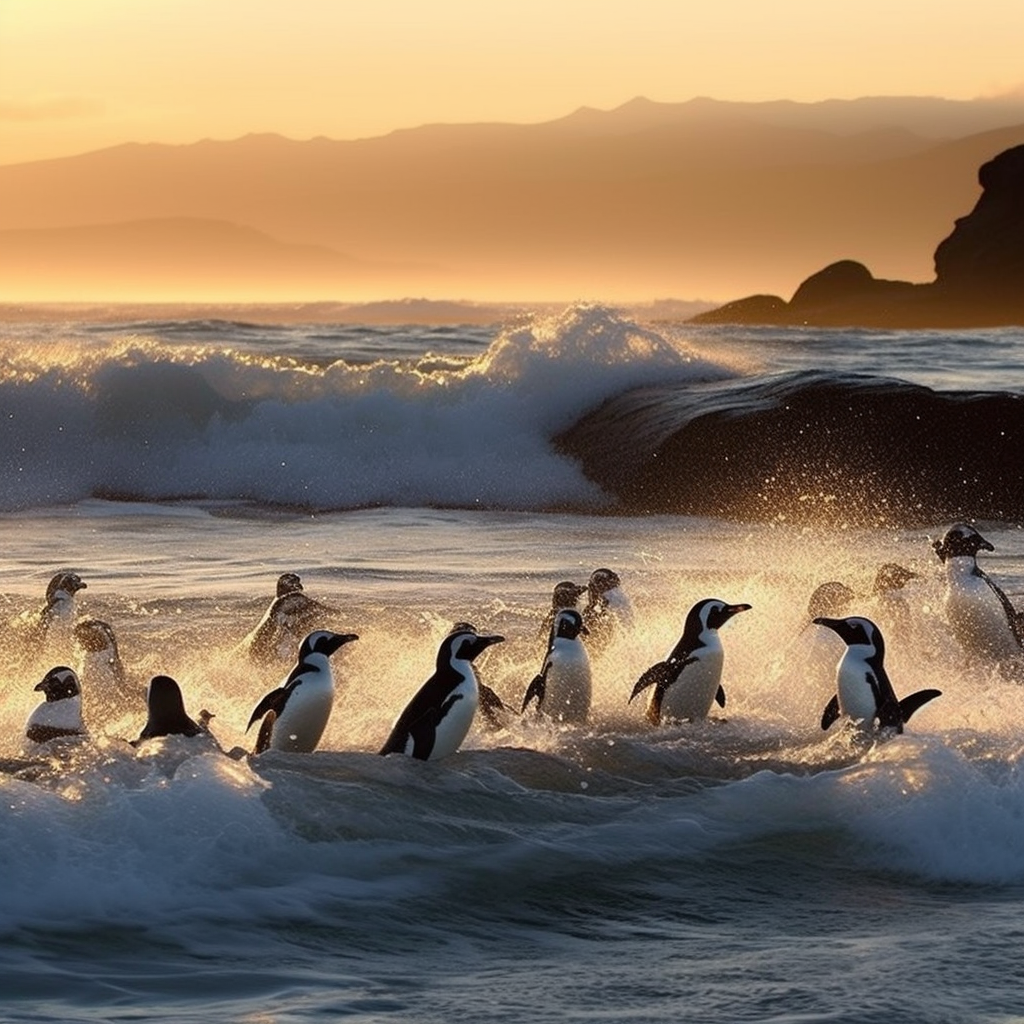Penguins are fascinating creatures that have captured the hearts of many people around the world. Known for their distinctive appearance and adorable waddling walk, these flightless birds are often associated with icy landscapes and frigid waters. But when it comes to their habitat, do penguins live in saltwater or freshwater? This question has intrigued many, and in this article, we will explore the environments where penguins thrive and uncover the truth behind their preferred choice of water. So, let’s dive in and discover the watery world of penguins!
Key Takeaways
- Penguins primarily live in saltwater environments, such as the oceans surrounding Antarctica and other coastal regions.
- Some penguins may temporarily inhabit freshwater areas, such as rivers or lakes, during certain parts of their life cycle.
- Penguins have specialized adaptations that allow them to thrive in cold, marine environments, including their waterproof feathers and streamlined bodies.
The Natural Habitat of Penguins: Saltwater or Freshwater?

A. Overview of Penguin Habitats
Penguins are fascinating creatures that have adapted to life in some of the harshest environments on Earth. While they are commonly associated with icy landscapes, not all penguins live in the same type of habitat. In fact, the majority of penguin species are found in the Southern Hemisphere, particularly in Antarctica. These incredible birds have evolved to thrive in both saltwater and freshwater environments, depending on their specific species and location.
B. The Role of Saltwater in Penguin Life
Saltwater plays a significant role in the lives of penguins. Penguins that inhabit coastal areas or islands in the Southern Ocean rely on saltwater for their survival. They spend a significant amount of their time swimming and foraging in the sea, where they hunt for fish, squid, and krill. These marine creatures form the staple diet of many penguin species.
Penguins have developed unique adaptations to cope with the challenges of living in saltwater. Their feathers are densely packed and coated with a layer of oil, which provides excellent insulation and waterproofing. This allows them to maintain their body temperature and stay dry while swimming in the cold ocean waters. Additionally, penguins have specialized glands that remove excess salt from their bodies, ensuring they can drink seawater without becoming dehydrated.
C. The Absence of Penguins in Freshwater Environments
While penguins are well-suited to life in saltwater, they are not typically found in freshwater environments. This is because their natural habitats, such as Antarctica and the surrounding islands, are predominantly icy and surrounded by the sea. Penguins have evolved to thrive in these cold, marine conditions, where they have access to an abundant food supply.
Freshwater environments, on the other hand, lack the necessary resources for penguins to survive. These habitats do not provide the same availability of food sources as the ocean. Penguins rely on the rich marine life found in saltwater ecosystems, which is essential for their diet and overall well-being. Without access to their preferred food sources, penguins would struggle to survive in freshwater environments.
In conclusion, penguins primarily live in saltwater habitats, where they have evolved to thrive. Their ability to swim, dive, and withstand the cold temperatures of the Southern Ocean is crucial for their survival. While they are not typically found in freshwater environments, penguins have adapted to their unique marine habitats, making them remarkable and resilient creatures of the sea.
Understanding Penguins’ Unique Adaptation: Converting Saltwater into Freshwater
Penguins are fascinating creatures that have adapted to survive in some of the harshest environments on Earth. One of the most remarkable adaptations they possess is their ability to convert saltwater into freshwater. This unique biological mechanism allows penguins to thrive in their marine habitats while still meeting their hydration needs. Let’s delve deeper into the biological mechanism behind this adaptation and understand its importance for their survival.
A. The Biological Mechanism Behind Saltwater Conversion
Penguins have a specialized gland located near their eyes called the supraorbital gland. This gland plays a crucial role in the conversion of saltwater into freshwater. When penguins ingest saltwater while hunting for fish in the sea, the excess salt is filtered out by their kidneys. However, some salt still remains in their bloodstream.
To remove this excess salt, penguins have evolved a fascinating adaptation. They excrete the excess salt through their supraorbital gland, which is connected to their nasal passages. This gland filters out the salt and secretes it as a concentrated solution through the penguin‘s nostrils. As a result, the penguins are left with freshwater that they can safely consume, quenching their thirst and staying hydrated.
B. The Importance of this Adaptation for Survival
The ability to convert saltwater into freshwater is of utmost importance for penguins’ survival in their marine environments. Here’s why:
-
Hydration in a saltwater environment: Penguins spend most of their lives in the ocean, where they are surrounded by saltwater. Unlike other marine animals, penguins cannot drink saltwater directly. Their unique adaptation allows them to extract freshwater from the saltwater they consume, ensuring they stay hydrated in their aquatic habitat.
-
Limited access to freshwater: Penguins primarily inhabit remote areas, such as Antarctica, where freshwater sources are scarce. By converting saltwater into freshwater, penguins can survive in these harsh environments without relying solely on limited freshwater resources.
-
Efficient hunting: Penguins are skilled hunters, and their ability to convert saltwater into freshwater plays a vital role in their hunting success. By being able to drink freshwater, penguins can maintain their energy levels and stay hydrated during long foraging trips, enabling them to catch fish and other prey more effectively.
-
Adaptation to cold conditions: Penguins live in extremely cold environments, where freshwater sources may freeze or be inaccessible. Their ability to convert saltwater into freshwater allows them to adapt to these cold conditions and survive without relying on external sources of freshwater.
In conclusion, penguins’ unique adaptation of converting saltwater into freshwater is a remarkable biological mechanism that enables them to thrive in their marine habitats. This adaptation ensures their hydration in a saltwater environment, provides them with a reliable water source in remote areas, aids in efficient hunting, and allows them to adapt to cold conditions. The ability to convert saltwater into freshwater is just one of the many fascinating aspects of penguins’ biology and their remarkable ability to survive in some of the most challenging environments on our planet.
The Necessity of Saltwater for Penguins

A. How Penguins Utilize Saltwater for Food and Survival
Penguins, those adorable aquatic birds that waddle on land and gracefully swim in the sea, have a fascinating relationship with saltwater. While they primarily inhabit the frigid regions of Antarctica, where the surrounding waters are predominantly saltwater, penguins have evolved to rely on the ocean for their sustenance and survival.
1. Penguin Diet
Penguins are known for their diverse diet, which consists mainly of fish, squid, and krill. These marine creatures thrive in saltwater environments, making the ocean an abundant source of food for penguins. By hunting and consuming these saltwater organisms, penguins obtain the necessary nutrients to fuel their active lifestyles and maintain their overall health.
2. Salt Glands
One of the remarkable adaptations that penguins possess is the presence of salt glands. These specialized glands, located near their eyes, play a crucial role in their ability to survive in saltwater habitats. Penguins have a unique mechanism that allows them to excrete excess salt from their bodies, preventing dehydration and maintaining their internal balance.
When penguins consume saltwater during their feeding expeditions, the excess salt is absorbed into their bloodstream. To eliminate this excess salt, penguins excrete it through their nasal passages, effectively removing the salt from their bodies. This process enables penguins to consume saltwater without suffering from the negative effects of high salt concentrations.
B. The Impact of Saltwater on Penguin Health and Physiology
Saltwater not only provides penguins with a vital source of food but also influences their health and physiology in various ways. Let’s explore some of the effects saltwater has on these remarkable creatures.
1. Hydration
Despite living in a cold environment, penguins still require hydration to survive. While they primarily obtain water from the food they consume, penguins also drink seawater when necessary. However, due to the high salt content in seawater, penguins must carefully regulate their intake.
Penguins have developed a unique adaptation that allows them to process the saltwater they consume. By utilizing their salt glands, penguins can excrete the excess salt, ensuring they remain hydrated without succumbing to dehydration caused by the high salt concentration.
2. Thermoregulation
Living in the frigid waters of Antarctica presents its own set of challenges for penguins. However, saltwater aids in their thermoregulation process, helping them maintain their body temperature in extreme conditions.
The high salt content in seawater lowers its freezing point, allowing penguins to swim and dive in sub-zero temperatures without the risk of freezing. This adaptation enables penguins to thrive in their icy habitat, where freshwater bodies would freeze over, limiting their ability to hunt and survive.
In conclusion, saltwater plays a vital role in the lives of penguins. From providing them with a diverse diet to aiding in their hydration and thermoregulation, the ocean is an essential component of their existence. Penguins have adapted to utilize saltwater effectively, allowing them to thrive in their unique and challenging environment. So, the next time you marvel at these incredible creatures, remember the crucial role that saltwater plays in their lives. Do Penguins Live in Water?
A. Penguins’ On-Land and In-Water Lifestyles
Penguins are fascinating creatures that have adapted to life in both water and on land. While they spend the majority of their time in the ocean, they also come ashore to breed, molt, and rest. This unique combination of on-land and in-water lifestyles sets penguins apart from other birds.
On land, penguins gather in large colonies, where they build nests and lay their eggs. These colonies can range from a few hundred to several thousand individuals, depending on the species. Penguins have strong, streamlined bodies that allow them to waddle and hop across the rocky terrain with relative ease. They use their wings as flippers to maintain balance while walking.
When it comes to swimming, penguins are truly in their element. They are exceptional divers and can spend long periods underwater, hunting for fish, squid, and krill. Penguins have evolved to be excellent swimmers, with their wings adapted into flippers and their bodies streamlined for efficient movement through the water. They use their webbed feet to propel themselves forward, while their wings help them steer and maneuver.
B. How Penguins Adapt to Life in Water
Penguins have several adaptations that enable them to thrive in their aquatic environment. One of the most notable adaptations is their waterproof feathers. Penguins have a dense layer of feathers that are tightly packed and coated with a special oil produced by a gland near their tail. This oil helps to repel water, keeping their feathers dry and insulating them from the cold temperatures of the ocean.
Another adaptation that aids penguins in their underwater pursuits is their ability to drink saltwater. Unlike most animals, penguins have a gland located above their eyes that filters out excess salt from their bloodstream. This gland allows them to drink seawater without becoming dehydrated. The salt is then excreted through their nasal passages, eliminating the need for them to find freshwater sources while at sea.
In addition to their physical adaptations, penguins also exhibit behavioral adaptations that contribute to their survival in the water. They have a highly efficient hunting technique, relying on their excellent eyesight to spot prey underwater. Penguins can dive to great depths, with some species reaching depths of over 500 meters (1,640 feet) in search of food. They can hold their breath for extended periods, thanks to their ability to slow down their heart rate and reduce oxygen consumption.
In conclusion, penguins are truly remarkable creatures that have adapted to thrive in both water and on land. Their unique combination of physical and behavioral adaptations allows them to navigate the challenges of their environment with ease. Whether waddling on land or gracefully swimming through the ocean, penguins are a testament to the wonders of nature’s ingenuity.
Why Do Penguins Need Water?
A. The Role of Water in Penguin’s Diet and Hydration
Water plays a crucial role in the lives of penguins, both in terms of their diet and hydration. As aquatic birds, penguins have adapted to thrive in marine environments, where they spend a significant portion of their lives. Let’s explore how water is essential to their survival.
1. Penguin Diet
Penguins are known for their diverse diet, which primarily consists of fish, krill, squid, and other small marine creatures. These food sources are found in abundance in the ocean, making it the natural habitat for penguins. By living in saltwater environments, penguins have easy access to their preferred prey, ensuring a steady supply of food.
2. Hydration
While penguins obtain a significant portion of their water intake from the food they consume, they still need to drink water to stay hydrated. Penguins have specialized glands located near their eyes, known as the supraorbital glands, which help them excrete excess salt from their bodies. This adaptation allows them to drink seawater without becoming dehydrated.
However, penguins do not solely rely on saltwater for hydration. They also seek out freshwater sources, such as melting ice or freshwater streams, to supplement their water intake. In environments like Antarctica, where penguins often reside, freshwater sources can be scarce. Therefore, penguins have developed the ability to drink both saltwater and freshwater, ensuring they stay hydrated even in challenging conditions.
B. Water as a Vital Component in Penguin’s Thermoregulation
Water also plays a crucial role in the thermoregulation of penguins. These remarkable birds have adapted to survive in extremely cold environments, and water is an essential component of their ability to regulate their body temperature.
1. Insulation
Penguins have a layer of dense, waterproof feathers that help insulate them from the cold water they inhabit. These feathers trap a layer of air close to the penguin‘s body, providing insulation and preventing heat loss. The presence of water is crucial in maintaining the effectiveness of this insulation. Without water, the feathers would lose their waterproofing properties, leaving the penguin vulnerable to the cold.
2. Cooling Mechanism
In addition to insulation, water also serves as a cooling mechanism for penguins. When penguins are exposed to high temperatures, such as during hot weather or when they are engaged in physical activity, they can release excess heat by panting and by dissipating heat through their feet. By standing in water or swimming, penguins can cool down their bodies and regulate their temperature more effectively.
In conclusion, water is vital to the survival of penguins. It not only provides them with a diverse diet but also plays a crucial role in their hydration and thermoregulation. By adapting to both saltwater and freshwater environments, penguins have developed remarkable abilities to thrive in their unique habitats. Understanding the importance of water in a penguin’s life helps us appreciate the incredible adaptations these aquatic birds have undergone to survive in their challenging environments.
How Do Penguins Get Fresh Water?

Penguins are fascinating creatures that have adapted to survive in some of the harshest environments on Earth. Living in the Antarctic region, where temperatures can drop well below freezing, penguins face unique challenges when it comes to obtaining fresh water. In this section, we will explore the different ways penguins acquire the water they need to survive.
A. The Process of Obtaining Fresh Water from Saltwater
Living in a habitat surrounded by saltwater, penguins have developed a remarkable adaptation to extract fresh water from the sea. Unlike humans and many other animals, penguins do not have access to freshwater sources such as rivers or lakes. Instead, they rely on a specialized gland located near their eyes called the supraorbital gland.
This gland plays a crucial role in the penguin‘s ability to survive in a saltwater environment. The gland filters excess salt from the penguin‘s bloodstream and excretes it through a small duct located near the beak. This process helps maintain the penguin‘s internal salt balance and prevents dehydration.
To obtain fresh water, penguins tilt their heads back and allow the saltwater to flow over their supraorbital gland. The gland then filters out the salt, and the penguin shakes its head to remove the excess saltwater. This ingenious adaptation allows penguins to drink the fresh water produced by their own bodies, helping them stay hydrated in their saltwater surroundings.
B. Fresh Water from Food: Another Source for Penguins
In addition to extracting fresh water from saltwater, penguins also obtain water from their diet. Penguins primarily feed on fish and krill, which contain a significant amount of water. By consuming these marine creatures, penguins supplement their water intake and reduce their reliance on the supraorbital gland.
The high water content in their prey helps penguins stay hydrated, especially during times when access to fresh water is limited. This adaptation is particularly important during the breeding season when penguins may have to travel long distances to find food and water for themselves and their chicks.
It is worth mentioning that the ability to obtain fresh water from food varies among penguin species. Some species, such as the Emperor penguin, have a higher dependence on the supraorbital gland for freshwater, while others, like the Adélie penguin, rely more on their diet for hydration.
In conclusion, penguins have evolved remarkable strategies to obtain fresh water in their saltwater environment. Their supraorbital gland allows them to filter excess salt from their bloodstream, while their diet provides an additional source of water. These adaptations enable penguins to thrive in their unique habitat and serve as a testament to their remarkable ability to survive in challenging conditions. Do Penguins Live in Salt Water?
A. The Saltwater Habitats of Different Penguin Species
Penguins are fascinating creatures that have adapted to life in some of the harshest environments on Earth. When it comes to their habitat, penguins are primarily found in the Southern Hemisphere, with the majority residing in Antarctica. While some penguin species do inhabit areas with access to both saltwater and freshwater, they are predominantly associated with saltwater habitats.
In Antarctica, where the majority of penguins live, the surrounding waters are predominantly saltwater. These icy waters are rich in marine life, providing an abundant food source for penguins. The cold temperatures of the Southern Ocean are ideal for penguins, as they have evolved to thrive in these frigid conditions.
Penguin species such as the Emperor penguin, Adélie penguin, and Chinstrap penguin are all found in the Antarctic region. These species spend most of their lives at sea, foraging for fish, krill, and squid. They rely on the saltwater environment for their survival, as it offers them a diverse range of prey.
B. The Impact of Living in Saltwater on Penguin Behavior
Living in a saltwater environment has shaped the behavior and lifestyle of penguins. These aquatic birds have evolved various adaptations to thrive in the oceanic realm. One notable adaptation is their ability to drink saltwater.
Unlike most animals, penguins have a specialized gland located near their eyes, known as the supraorbital gland. This gland filters excess salt from their bloodstream, allowing them to excrete it through their bills. This unique adaptation enables penguins to consume saltwater without dehydrating themselves.
However, penguins do not solely rely on saltwater for hydration. They also have the ability to drink freshwater when it is available. During their time on land, penguins can consume snow or freshwater from melting ice to supplement their hydration needs. This flexibility in their drinking habits allows them to adapt to their environment and survive in both saltwater and freshwater habitats.
In addition to their drinking habits, penguins exhibit various other behaviors influenced by their saltwater environment. For instance, they are excellent swimmers, using their flippers to navigate through the water with remarkable agility. Penguins can dive to impressive depths, reaching up to 1,700 feet, and hold their breath for extended periods of time while hunting for food.
Furthermore, living in saltwater has influenced penguins’ social behavior. They often gather in large colonies on land, where they mate, breed, and raise their chicks. These colonies provide a sense of safety and protection against predators, as well as a platform for social interaction among penguins.
In conclusion, while penguins may encounter freshwater sources in their habitats, they are primarily associated with saltwater environments. Their ability to drink saltwater and adapt to life at sea has allowed them to thrive as remarkable marine creatures. Penguins’ unique adaptations and behaviors make them a fascinating subject of study for researchers interested in the ecology and biology of these incredible birds. Conclusion
In conclusion, penguins are primarily marine birds that live in saltwater environments. They have adapted to life in the ocean and rely on saltwater for their survival. Penguins spend most of their time at sea, hunting for fish and other marine creatures. While they may come ashore to breed and raise their young, they always return to the ocean for food. Penguins are well-suited to the challenges of living in saltwater, with their streamlined bodies, waterproof feathers, and unique ability to drink saltwater. These fascinating creatures have evolved to thrive in the harsh conditions of the Antarctic and other cold-water regions. So, if you ever find yourself wondering where penguins live, remember that their true home is in the salty depths of the ocean.
Frequently Asked Questions
How do penguins convert saltwater into freshwater?
Penguins have a specialized gland in their bodies called the supraorbital gland, which functions like a desalination plant. It filters out the salt from the seawater they ingest, allowing them to survive in their saltwater habitats. The salt is then excreted through their beaks.
Do penguins need saltwater?
Yes, penguins do need saltwater. Most penguin species are marine birds and live in saltwater environments. They have adapted to this environment and rely on it for their food source, which primarily consists of krill, squid, and small fish.
Do penguins live in saltwater or freshwater?
Penguins are primarily saltwater animals. They live in the Southern Hemisphere, particularly in Antarctica, and spend most of their lives in the ocean. However, there are some species, like the Galapagos penguin, that can also survive in warmer climates and freshwater environments.
Do penguins live in water?
Penguins spend about half of their lives in water and the other half on land. They are excellent swimmers and divers, and they hunt for their food in the water. Their bodies are well adapted for life in water, with a streamlined shape and strong flippers for propulsion.
Why do penguins need water?
Penguins need water for several reasons. They are aquatic birds and their primary food sources, such as fish, squid, and krill, live in the ocean. Water also provides a means for them to escape from land-based predators. Additionally, swimming is a crucial part of penguin behavior and lifestyle.
How do penguins get fresh water?
Penguins get fresh water from the food they eat and by drinking seawater. They have a special gland that removes salt from the seawater, allowing them to hydrate. In Antarctica, penguins may also consume snow for fresh water.
Do penguins live in salt water?
Yes, most penguin species are adapted to live in salt water. They are marine life and spend a significant portion of their lives in the ocean. However, they also spend time on land for breeding and molting.
What is the typical penguin habitat?
The typical penguin habitat is in the colder regions of the Southern Hemisphere, particularly Antarctica. However, some penguin species can also be found in more temperate regions like South Africa and New Zealand, and the Galapagos penguin lives near the equator.
What is the impact of saltwater vs freshwater on penguin adaptation?
Penguins are primarily adapted to saltwater environments. They have a special gland to filter out salt from the seawater they drink. This adaptation allows them to thrive in the ocean, where they hunt for food. Freshwater doesn’t provide the same diet options, which is why most penguin species are found in saltwater habitats.
What are the main factors influencing penguin behavior?
Penguin behavior is influenced by several factors including the need for food, reproduction, and survival. Seasonal changes, particularly the harsh winters of Antarctica, also play a significant role in their behavior. Penguins are social animals and their behavior is often synchronized for activities like hunting, breeding, and molting.




